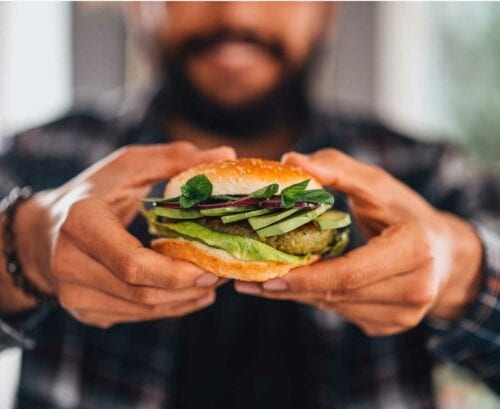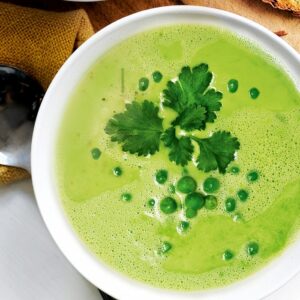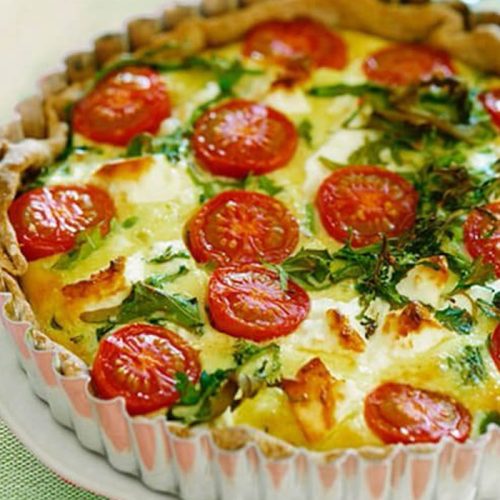
Meat-free has gone mainstream, but does that mean we should be swapping steak for sprouts? HFG Australia editor and dietitian Brooke Delfino weighs up the benefits of plant-based eating.
Vegan, vegetarian, meat-free… There’s no denying the dramatic shift towards plant-based eating in recent years, but one size no longer fits all. In fact, ‘plant-based’ might not even mean what you think. So if the thought of following a plant-based diet sounds boring or restrictive, think again because it’s actually pretty simple. You can be vegetarian, vegan, pescatarian or even an enthusiastic meat eater — sometimes all in the space of a week! It’s an approach we like to call flexitarian, and it’s a way of eating that’s becoming increasingly popular.
Recent data revealed a whopping 80 per cent of us are trying to include more meat-free meals into our diet, and 1.5 billion people, globally, identify as vegetarian. Despite this, there are still plenty of myths and misconceptions around meat-free eating, so we unpack the facts.
5 key principles of a plant-based diet
1. Eat mostly plants
Make plant foods — fruit, vegetables, whole grains, nuts, seeds, legumes — the basis of your diet. Build on this with eggs, dairy, seafood or other animal proteins as you choose.
2. Aim for diversity
Your goal is to eat 30 or more different plant foods every week, so aim for variety and different colours. Experiment with herbs, spices, different nuts and seeds, as well as new grains or legumes you don’t usually eat.
3. Choose whole, not refined
Fill your shopping basket — and plate — with whole plants that have been minimally processed. Think dense, grainy bread, rolled oats, whole nuts and fresh fruit and veg instead of processed cereals, white breads and ‘fruit-based’ snack bars. Eating this way means more nutrients and less waste. It’s a win for your health and the planet.
4. Focus on inclusion, not exclusion
For a long time, healthy eating has been about what we need to eat less of. It’s time to flip your thinking and focus on the foods to enjoy more of instead. Plant-based eating is not restrictive because nothing is off limits. Simply start by trying to eat more vegetables each and every day.
5. Get creative with flavour
Forget the idea that meat-free meals are boring and tasteless. Inject flavour into vegetables, grains and legumes with herbs, spices, garlic, extra-virgin olive oil and different cooking methods, such as roasting, braising and slow-cooking.
Q What are the benefits of eating less meat and more veg?
The recent focus on cutting back (or out) meat is a result of studies revealing plants are our most powerful ally against chronic disease. A plant-based, Mediterranean-style diet canlower your risk of developing heart disease, diabetes, cancer and obesity, while eating 30 or more different plants a week increases gut bacteria diversity.
But it’s not just good health we need to think about these days. We increasingly need to consider the environment when we choose what to have for dinner. Opting towards a more plant-based diet by eating less meat is a vital step towards the long-term survival of the planet and its people. That’s because the global production of animal food products is inefficient, requiring large amounts of precious land and water.
Q Is plant-based the same thing as vegetarian?
No. Plant-based is the buzzword of the moment, popping up everywhere from cafe menus to frozen meals. But where there’s buzz, there’s also confusion. Many people think plant-based means a bland and boring diet of salads and leafy vegetables. But that’s not quite true.
Plant-based simply means that plants form the foundation of your diet — it doesn’t mean meat is off the menu. If most of your diet is made up of fruit, veg, legumes, nuts and whole grains, with a small amount of lean meat and dairy, then your diet is plant-based — and you’ll enjoy all the health benefits of following this dietary pattern.
Q Do vegetarian diets provide enough protein?
Yes! Most people have no problem meeting their protein needs, regardless of their meat-eating status. While steak and chicken usually spring to mind when talk turns to protein, don’t forget plants can provide a big protein punch, too. Legumes such as chickpeas, lentils and beans are some of the richest protein sources, along with tofu, tempeh, soy milk, nuts and seeds. If dairy, eggs or seafood are on your vegetarian menu, that’s another win in the protein stakes.
Q Are plant milks a good substitute for cow’s milk?
Calcium-fortified soy milk is the winner. Compared to other plant-based milks, soy milk has the closest nutrient profile to cow’s milk. It has a comparable amount of muscle-building protein to help you feel full, and is often fortified with calcium for strong bones and teeth.
You may have noticed the recent popularity of ‘mylks’ made from grains or nuts like almond, or rice and oat milk. These dairy-free alternatives don’t always live up to the hype. They’re generally low in protein and, unless fortified, lacking in key micronutrients, including calcium. Such ‘mylks’ are made by soaking a small portion of nuts or grains (often less than two per cent) in water, and then blitzing together, so you don’t end up with many grains or nuts in the finished product.
Q How do I get my partner and/or kids on board?
Converting hungry, growing, meat-eating enthusiasts to an eating pattern that’s centred around plant foods might seem daunting, but it’s easier than you think. Remember, plant-based doesn’t have to mean meat-free, so start by focusing on inclusion and not exclusion. This is one of the key principles of a plant-based diet.
Instead of serving meat as the star event at dinner time, prepare a delicious roasted vegetable salad and serve grilled chicken or fish on the side. Or add a can of lentils or chickpeas to your favourite bolognese or taco mix. Experiment with flavour-packed mains like falafels, vegetarian pizzas, curries and traybakes as a way to shift the focus from meat to veggies. Finally, involve your family in meal planning to ensure there’s something for everyone. See our vegetarian and vegan recipes for delicious plant-based dinner inspiration.
Q Do I need an iron supplement on a vegetarian diet?
Vegetarians who are eating a varied and well-balanced diet are not at any greater risk of iron-deficient anaemia than non-vegetarians. Iron supplements are generally used by pregnant women and people diagnosed with iron-deficient anaemia.
A well-planned vegetarian diet that’s rich in whole grains, legumes, nuts, seeds and leafy green veg will provide an adequate intake of iron. You can reduce your risk of low iron levels by eating plenty of foods rich in vitamin C. Pairing certain foods can help improve nutrient absorption, so eat the following non-haem (plant-sourced) iron-rich foods with the following vitamin C-rich foods to encourage iron absorption:
- Cereal + citrus fruits and juice
- Nuts + kiwifruit
- Legumes + tomato
- Green leafy veg + capsicum
- Wholegrain breads and cereals + broccoli.
Your plant-based pantry checklist
- Rolled oats
A great source of quality carbohydrates to provide long-lasting energy. - Nut butters
These provide healthy fats, protein and a range of vitamins and minerals. - Canned legumes (chickpeas, kidney beans, lentils)
A convenient protein option to throw into salads or curries. - Nuts
A winning combo of healthy fats, muscle-building protein and good gut fibre. - Tofu
A versatile plant protein you can use in a variety of sweet and savoury dishes. - Wholegrain bread
A rich source of low-GI carbs. If you pick a loaf with added seeds, such as soy-linseed, you’ll boost your intake of healthy omega-3 fats, too. - Soy milk
A good replacement for cow’s milk if fortified with calcium
Vegetarian vocab
A quick overview of the spectrum of plant-based eating descriptions:
- Vegan
Avoids eating all animal products - Lacto-vegetarian
Avoids meat, seafood and eggs, but includes dairy foods - Lacto-ovo vegetarian
Avoids meat and seafood but includes dairy and eggs - Pescatarian
Avoids meat and poultry but includes some seafood, dairy and eggs - Flexitarian
Includes animal products in moderation.
How much protein in plant-based foods?
- Handful (30g) nuts = 8g protein
- Small can (220g) baked beans = 11g protein
- ½ block (125g) firm tofu = 15g protein
- 2 slices grainy bread = 8.5g protein
- ½ cup (40g) rolled oats = 5g protein
- ½ can (200g) chickpeas = 13g protein
Article sources and references
- Animals Australia. 2019. Surge in Aussies eating vegetarian continues. Accessed January 2022https://animalsaustralia.org/latest-news/study-shows-surge-in-aussies-eating-veg/#:~:text=Research%20conducted%20by%20Roy%20Morgan,all%20or%20almost%20all%20vegetarian.
- Australian Bureau of Statistics (ABS). 2015. Australian Health Survey: Usual nutrient intakes, 2011–12. IRON. https://www.abs.gov.au/statistics/health/health-conditions-and-risks/australian-health-survey-usual-nutrient-intakes/latest-release
- Baker Heart & Diabetes Institute. 2017. Omega-3 fatty acids. Accessed January 2022https://www.baker.edu.au/-/media/documents/fact-sheets/baker-institute-factsheet-omega-3.pdf
- Food & Beverage Industry News. 2021. Australians are focusing on health with 80 per cent trying meat-free meals. Accessed January 2022https://www.foodmag.com.au/australians-focusing-health-80-per-cent-trying-meat-free-meals/
- Rossi, M. 2021. Eat More, Live Well. Penguin Random House UK.https://www.penguin.co.uk/books/319/319229/eat-more--live-well/9780241480465.html
www.healthyfood.com










